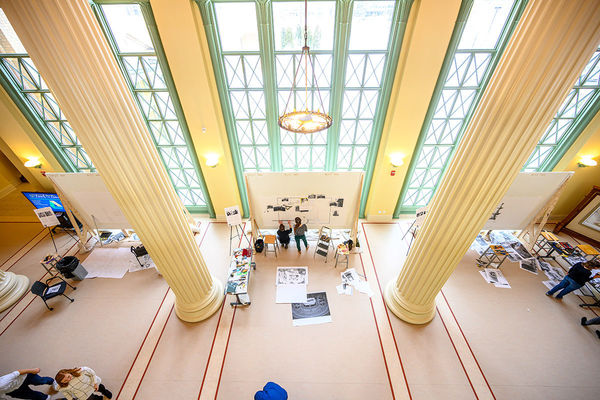
Those passing through the Walsh Family Hall of Architecture on January 23rd and 24th might have wondered at all the activity in the Stoa, where groups of students sketched busily away on three 4’ x 6’ canvases standing upright against the floor-to-ceiling windows. Shadows lengthened with the day as an ever-changing audience looked on to witness each group’s progress, creating the bustling, market-like atmosphere the Stoa was designed to reflect.
This live-drawing event—which had three groups of architecture students drawing on two consecutive days from 9:00 a.m. to 5:00 p.m.—was organized by Scenographia, a non-profit organization whose ultimate mission is to encourage others to see hand drawing not as a rare skill, but as a fully human one that’s accessible to all. What better way to communicate that message than demonstrate it live for the public to see?
“We’re trying to break the ‘I could never do that’ stigma of hand drawing,” said Jennifer Frantik ‘20, Scenographia’s Media Director. “We want people to see the process of creation as well as the finished product. It all starts on a blank canvas, and they see it all—even the mistakes.”
The three teams that participated were made up of fifth-year and graduate architecture students, who after being selected last semester had one month to complete the designs they would recreate on the large canvases. The assigned theme was South Bend architecture in the 1920s.
“Before researching, we were not aware how much great architecture happened in the city in the 1920s, and we decided to depict several buildings that were the most culturally important,” said Madeline Fairman ‘20, one of the participants. “The drawing focuses on twenties South Bend as a hub of transportation, industry, and education.”
Inspiration for the theme is tied to the Architecture Library’s Building South Bend project, created to study the past, present, and future architecture in the city of South Bend through a website, mobile application, 3D printed models, and an immersive 3D virtual tour of downtown South Bend in the 1920s.

Scenographia’s mission aligns with the School’s emphasis on hand drawing, which is unique among architecture programs across the country. Whereas most programs jump into digital design without first mastering hand drawing, at Notre Dame students spend their first three years in the architecture program drafting exclusively by hand, giving them a distinct advantage after graduation over other job seekers without such skills.
“I am consistently impressed by the talent coming out of Notre Dame's Architecture program,” said Adrian Taylor, Co-Founder of Scenographia. “For many years now I have observed that a very high percentage of the architects my office engages with—those who regularly include ornament in their designs—have come through the Notre Dame School of Architecture.”
Learning to draw well by hand is about more than professional edge, however. Scenographia acknowledges that hand drawing is an inherently human ability, one that our species has been using to express itself for millennia, and that practicing it in the company of an audience helps restore its image as an approachable art form in public consciousness.
“We believe that a humane built environment is one first drawn by hand, and our focus is on the celebration of this skill and the experience of creating large works of art specifically in concert with the audience, wherein both artist and observer play a role in the creation,” said Matt McNicholas, Co-Founder of Scenographia. “Without the audience, the act of drawing is simply a personal expression, but by involving the viewer and creating these murals in public and highly-trafficked places, we aim to fulfill our mission of inspiring people to pick up their own media and express themselves.”
Each drawing’s progression was recorded, and timelapse videos will be released in the coming weeks. Learn more about past and upcoming Scenographia events here.